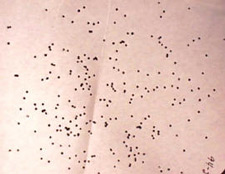Home | Glossary | Resources | Help | Contact Us | Course Map
Archival Notice
This is an archive page that is no longer being updated. It may contain outdated information and links may no longer function as originally intended.
Shot Patterning
The shot pattern analysis process pertains to firearms that fire multiple pellets. Pellet patterns can be measured for a much greater distance than those discussed previously. Distance determinations based on shot patterns are dependent on the reproduction of the physical environment where the shooting occurred. This means that the suspect firearm must be obtained; the ammunition used by the suspect must be identified and duplicated; and a questioned or evidence shot pattern must have been recovered, such as a victims garment or other object.
Although shot patterns in victims garments or other objects are normally visually examined and chemically processed for the presence of nitrite compounds and lead, the basis for most distance determinations is based upon the size of the shot pattern and pattern reproduction.
Pellet patterns may be elongated in shape because a relative angle of other than ninety degrees existed between the barrel of the firearm and the area of impact at the time of discharge. While it is relatively simple to determine the presence of such an angle, it is unlikely that any precise determination of the angle is possible. The comparison should be focused on the more narrow dimension of the pattern.
In patterns involving larger size pellets as found in buckshot, the resulting pattern may have fewer holes than the expected number of pellets in the load.
A buckshot pattern may have fewer holes present as a result of one or more of the following:
- Multiple pellets could pass through a single hole.
- An intermediate object may be involved at the time of discharge.
- Factory loaded shotshell may not contain the number of pellets indicated by the manufacturer.
| Note: |
| Handguns also can be loaded with various pellet loads, producing a shot pattern. |
Additional Online Courses
- What Every First Responding Officer Should Know About DNA Evidence
- Collecting DNA Evidence at Property Crime Scenes
- DNA – A Prosecutor’s Practice Notebook
- Crime Scene and DNA Basics
- Laboratory Safety Programs
- DNA Amplification
- Population Genetics and Statistics
- Non-STR DNA Markers: SNPs, Y-STRs, LCN and mtDNA
- Firearms Examiner Training
- Forensic DNA Education for Law Enforcement Decisionmakers
- What Every Investigator and Evidence Technician Should Know About DNA Evidence
- Principles of Forensic DNA for Officers of the Court
- Law 101: Legal Guide for the Forensic Expert
- Laboratory Orientation and Testing of Body Fluids and Tissues
- DNA Extraction and Quantitation
- STR Data Analysis and Interpretation
- Communication Skills, Report Writing, and Courtroom Testimony
- Español for Law Enforcement
- Amplified DNA Product Separation for Forensic Analysts


